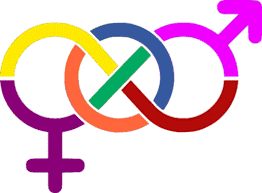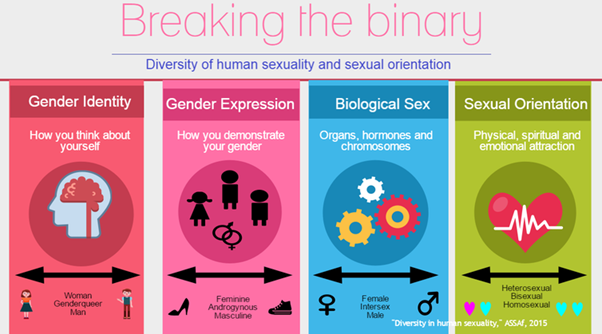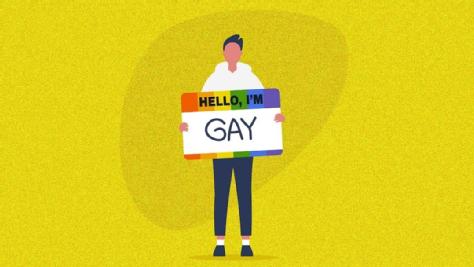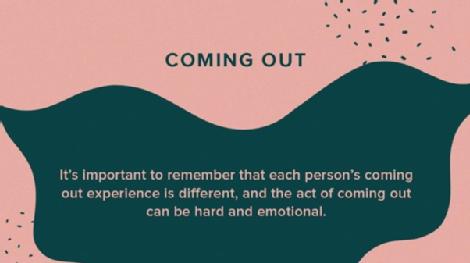Sexuality, Sexual and Romantic Orientation, and ‘Coming Out’

In its broadest sense, the term ‘sexuality’ describes the whole way a person expresses themselves as a sexual being. It describes how they choose to express that sexuality, and any preference they may have towards the gender(s) of sexual partner they choose (their sexual orientation).
Sexuality may be experienced and expressed in a variety of ways; including thoughts, fantasies, desires, beliefs, attitudes, values, behaviours, practices, roles, and relationships.
Similar to sexual orientation, people also have a romantic orientation, which describes any preference they may have towards the gender(s) of romantic partner they choose.
The table below explains some common sexual and romantic orientations, though there are many more in use. All sexual and romantic orientations are natural and valid.
|
|
Sexual Orientation |
Romantic Orientation |
|
Attracted to people of a different gender |
Straight/Heterosexual |
Heteroromantic |
|
Attracted to people of the same gender |
Gay/Lesbian/Homosexual |
Homoromantic |
|
Attracted to more than one gender of people |
Bisexual |
Biromantic |
|
Attracted to people of all genders/regardless of gender |
Pansexual |
Panromantic |
|
Attracted to people rarely, weakly, or not at all |
Asexual |
Aromantic |
There is a huge variety of sexual and romantic expression: the way we choose to behave sexually and romantically is usually both individual and complex; it rarely falls into neat categories or lends itself to simple labelling.
While orientation labels can feel like a restrictive definition to some, they often give people who do not feel they share the major assumptions of the dominant heterosexual mainstream the voice, pride and sense of validation that comes from discovering an identity and a shared experience with others.

Coming Out
Coming out refers to the ongoing process of disclosing your sexual and/or romantic orientation to others. This predominantly relates to people who are part of the LGBTUA+ community.
Choosing whether to come out, when, and to who, is a personal decision, and there are no right and wrong choices. Some people may decide that it is not safe for them to come out, due to the attitudes and beliefs of those around them, or due to the legal situation in a location they live, work or study.

Coming Out to Yourself
Before you can come out to anyone else, you may need to come out to yourself. There is no hard and fast rule about when or how this happens. Some people are certain of their sexuality from a very young age; for others it can happen much later in life.
Whilst there have been shifts in attitudes, changes to the law, and greater visibility for the LGBTUA+ community, many people still experience discrimination and prejudice based on their sexuality/sexual and romantic orientation. Therefore the decision to come out to yourself can still be a very scary one and can be a period of upheaval and uncertainty, particularly if attitudes within your family or wider community are not positive towards LGBTUA+ identities/less willing to embrace differing sexualities.
If you would like to read more about issues specific to trans people, please read our trans information sheet.
Coming Out to Others
Families often have a specific vision of their children’s’ future, and can be very upset when it becomes clear that it is not going to be realised. Similarly, family, friends and other groups may have their own very definite opinions or prejudices relating to sexuality.
It may be helpful to come out to people who you know will validate and celebrate your sexuality, especially if there are other people who you feel may not be so accepting. You may want to:
- Find a source of community by contacting an LGBTUA+ group such as Warwick Pride (for students) or Warwick’s LGBTUA+ Staff Network (for staff).
- Sign up to a buddy scheme such as Warwick Pride’s ‘Befriending Scheme’ or the staff LGBTUA+ buddy scheme, where you can talk with another LGBTUA+ person.
- Identify any people you know who are vocal supporters of the LGBTUA+ community – you might want to come out to them as a first step.
- Decide who you ultimately would like to come out to e.g. family, friends, coursemates, hallmates and/or colleagues. You don’t have to share your sexuality with anyone unless you want to, including tutors and department staff.
- Choose your medium of coming out: in person, by telephone, writing a letter... If you are worried that someone will be hostile to what you have to say, writing might give them time to assimilate the news better.
- Avoid feeling pressured to rush and follow your own timetable - it's your life and your sexuality. Don't feel you have to tell people until you are ready, or at all.
- Remember that people’s initial viewpoint about your sexuality may not be fixed. Some people who hold prejudiced views re-examine them when once they know someone who is LGBTUA+. Equally, some people who seem supportive may struggle when someone they know tells them about their sexuality.
- Try not to be too upset by an initial poor reaction from someone you come out to. Many people react badly when they are faced with something that has shocked them, and may need some time to adjust.
- Try not to feel responsible for other people’s reactions. None of us have control over our sexual and romantic orientation, and we don't need to apologise for them.
Support:
- Warwick Pride: https://warwickpride.org/
- http://www.themix.org.uk/sex-and-relationships/sexuality/how-to-come-out-3741.html?gclid=CLmrt87zi88CFYYp0wodRV8Nxw LGBT support for under 25’s
- www.bgiok.org.uk - site set up by a student called ‘Being Gay is OK ‘
- https://lgbt.foundation/ LGBT Foundation for advice, support and information
- Albert Kennedy Trust
- Hero - the Health Equality and Rights Organisation for LGBTQ+ people (includes GMFA, gaymen's health project)
- LGBT helpline
- Pink Therapy - directory of qualified therapists who identify as or have an understanding of minority sexual and gender identities
- Faith based groups and organisations for the LGBT+ community
- www.bicommunitynews.co.uk - site includes information challenging stereotypes of bi people, defining bisexuality and providing links to the bi community
- www.fflag.org.uk - ‘Families and Friends of Lesbians and Gays’
- http://www.stonewall.org.uk/help-advice?gclid=CMrRvPLyi88CFbQV0wodl74KKg –help and advice for LGBT people and their allies
- http://www.imaan.org.uk/ Muslim LGBT Support Group
- http://www.jglg.org.uk/ - Jewish Gay and Lesbian Group.
- Family Outing: The guide to coming out for gays, lesbians and their parents Chastity Bono ,Billie Fitzpatrick; Written from personal experience and includes stories of people who came out to their families
- How to cope with doubts about your sexual identity MIND booklet which contains tips and information on agencies that may be helpful
- Outing Yourself Signorile; Practical things to consider when coming out to family and friends
- The new gay teenager Savin-Williams.R; Interesting take on what sexuality means to young people, including personal accounts
- National AIDS Helpline - 0800 137 437
Some terms related to sexuality
- Ally - a (typically) straight and/or cis person who supports members of the LGBTUA+ community.
- Aromantic – refers to a person who does not experience romantic attraction, or who experiences it weakly or rarely.
- Asexual (or ace) – refers to a person who does not experience sexual attraction, or who experiences it weakly or rarely.
- Bi – refers to a person who is sexually and/or romantically attracted to more than one gender of people.
- Biromantic – refers to a person who is romantically attracted to more than one gender of people.
- Bisexual – refers to a person who is sexually attracted to more than one gender of people.
- Biphobia - the fear or dislike of someone who identifies as bi.
- Coming out – when a person discloses their sexual or romantic orientation, or trans identity, to another person (e.g. as lesbian, gay, bi or trans).
- Gay – refers to a person who is sexually and/or romantically attracted to people of the same/similar gender.
- Heteroromantic – refers to a person who is romantically attracted to people of a different gender.
- Heterosexual or Straight - refers to a person who is sexually attracted to people of a different gender.
- Homoromantic – refers to a person who is romantically attracted to people of the same/similar gender.
- Homosexual – this might be considered a more medical or old-fashioned version of the term ‘gay’, used to refer to a person who is sexually attracted to someone of the same/similar gender.
- Homophobia - the fear or dislike of someone who identifies as lesbian, gay (or LGBTUA+ more broadly).
- Lesbian – refers to a woman who sexually and/or romantically attracted to other women.
- LGBT – the acronym for lesbian, gay, bi and trans.
- LGBTUA+ - the acronym used at Warwick to refer to the community of lesbian, gay, bi, trans, undefined and asexual or aromantic people, and others affected by the same or similar prejudices and discrimination.
- Outed – when a person’s sexual or romantic orientation or gender identity is disclosed to someone else without their consent.
- Panromantic – refers to a person who is romantically attracted to people of all genders, or regardless of gender.
- Pansexual - refers to a person who is sexually attracted to people of all genders, or regardless of gender.
- Queer – in the past a derogatory term for LGBT individuals, the term has now been reclaimed by some people who don’t identify with traditional categories around gender identity and sexual orientation (though be aware that it is still felt to be a slur by some).
- Questioning – the process of exploring your own sexual and/or romantic orientation, and/or gender identity.
- Romantic orientation - describes any preference a person may have towards the gender(s) of romantic partner they choose.
- Sexual orientation – describes any preference a person may have towards the gender(s) of sexual partner they choose.
- Trans – a trans person is someone who identifies as a gender different to that which they were assigned at birth.

